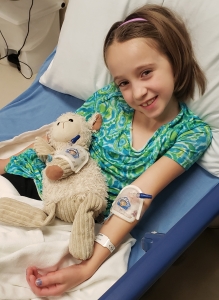 Clinical excellence is good.
Clinical excellence is good.
Clinical excellence with reminder scripts of what to say and do during a clinical visit is better.
Clinical excellence with Caring Out Loud® is BEST.
This highest level of caring — Caring Out Loud® — goes beyond what the provider says and does and adds the component of how the provider makes the patient feel … from the patient’s perspective. Caring Out Loud® is essentially narrating the process of care before, during, and after, in a way that takes into account the patient’s individual needs, wishes, emotions and preconceived ideas about their experience. With organizationally prescribed scripts and actions (like AIDET and others) as a foundation, Caring Out Loud® equips providers with additional tools to ensure that individual patients “feel” extraordinarily well-cared for.
*************
The following is a story from one of our team members about an experience she and her family had recently:
My family and I had an experience with one nurse recently who showed us how a simple and elegant tool like Caring Out Loud can have a powerful effect on the patient experience.
Earlier this year my eight year old broke her arm. She was riding her new skateboard when I heard a shriek and then a deafening wail. She had landed right on her elbow and she was in agony. We rushed to the local urgent care to confirm what we already suspected, that indeed her arm was broken. The clinicians there were very skilled at their job, but I immediately noticed they lacked a warmth and friendliness.
Clinical Expertise Alone Isn’t Enough
The physician examined her arm and then referred us for x-rays, which they needed to send to the referring hospital. In the x-ray suite, the technician brought us back to the room and told my daughter where to sit. (No greeting or introduction. No smile. Minimal eye contact.) This tech was all business. She sat my daughter on a stool at the edge of the table and then she twisted and turned my daughter’s arm so that the X-ray machine could capture the best possible images.
She was careful as she moved her arm, but she wasn’t exactly full of caring words. My daughter winced in pain and tears streamed down her face. I had to remain behind the wall for safety reasons but as I verbally consoled my daughter, the tech said nothing other than You need to hold still or I’ll have to do it again.
The images she shot were exactly what the hospital needed so obviously she had the clinical expertise to do her job. However, she showed zero empathy and zero concern for the pain that my daughter was experiencing. As a mom, I can tell you it was absolutely excruciating to see the look of pain on my little girl’s face and hear her screaming as this clinician twisted and straightened and bent her broken arm this way and that on the X-ray table.
Creating a Memorable Experience (aka: This Is What Caring Out Loud Looks Like)
Fast forward about 4 hours. We’re in a patient room at the hospital. It’s close to midnight. My daughter is exhausted but thankfully she has some ibuprofen in her system and her arm has been temporarily set. Her pain has subsided a little.
A nurse enters our room and walks calmly to my daughter’s bedside. Hello, Bridget, I’m Nurse Carrie and I’ll be taking care of you tonight. I’m so sorry you broke your arm. How are you feeling?
Then she turned to my husband and I, shook our hands, and reintroduced herself.
She pulled up a chair, rolled it close to my daughter’s bedside and sat down. They were at eye level.
You must be a little scared being in a hospital so late at night. I want you to know we’re all here to take good care of you and help your arm feel better.
Then, Nurse Carrie pointed to the little stuffed animal nestled beneath my daughter’s good arm.
Well who do we have here?
(Nurse Carrie was kind, but she was also OBSERVANT (a key component to mastering the Caring Out Loud technique.)
My daughter beamed and said This is Lambie.
Did Lambie break his arm, too?
My daughter shook her head. Yes.
Well I brought some dressing with me because I need to give you an IV and then I need to wrap your arm so the doctor can take a good look at it. But I have a feeling Lambie might want to have his IV put in first, what do you think?
My daughter smiled and agreed.
The nurse walked around to the other side of the bed and proceeded to give Lambie a pretend IV. Without missing a beat and with no hint of embarrassment, she spoke directly to the stuffed animal.
Now Lambie, this might pinch a little bit but if you can be brave and take a deep breath and blow it out when I tell you I promise it won’t hurt for long.
 And then she poked the little stuffed animal, inserted the pretend IV, and wrapped some gauze around it. She looked at my daughter and said, Well Lambie is all set! Are you ready for yours?
And then she poked the little stuffed animal, inserted the pretend IV, and wrapped some gauze around it. She looked at my daughter and said, Well Lambie is all set! Are you ready for yours?
Clutching Lamb with her one good arm, my daughter smiled and said yes.
________________
Of course, the doctor reset her arm and in about six weeks she was good as new. But I couldn’t stop thinking about the two very different experiences we’d had with the clinician in the X-ray lab (horrible) and this nurse in the hospital setting (memorable).
Both had the clinical expertise to get their job done.
Both were credentialed professionals.
But only one delivered a positive memorable patient experience using the kindness and compassion of Caring Out Loud®. In short, it all comes down to delivering personalized care by: being attentive to details, skilled at using empathy, a good communicator, and then ultimately, putting it all together to deliver an exceptional and memorable patient experience.
*********
Caring Out Loud® is just one of the many tools we teach care teams to use and hardwire into their “Always Playbooks” as part of our Culture Transformation engagements. I’d love to know your thoughts. Drop me a line in the comments here, send me an email at jake.poore@wecreateloyalty.com, or call 407.859.2826 to speak to any of our team members.





